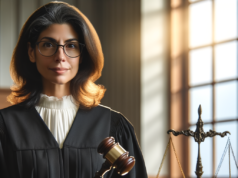Table of Contents

Loving v. Virginia is a landmark case in the United States Supreme Court that led to the legalization of interracial marriage across the country. The case was argued in 1967 and was a pivotal moment in the civil rights movement, challenging laws and social norms that had long relegated people of different races to separate and unequal spheres. This article provides a detailed overview of Loving v. Virginia, including when it happened, how it ended, the process, and how it has influenced the United States legal system. Additionally, it covers ten fascinating facts about this historic case.
Background of the Case
In 1958, Mildred Loving, a Black woman, and Richard Loving, a white man, were arrested in Virginia for violating the state’s anti-miscegenation laws. At the time, interracial marriage was illegal in the state, and the Lovings were charged with “unlawful cohabitation” and “lewd and lascivious behavior.”
The Lovings challenged the constitutionality of the Virginia law, arguing that it violated their Fourteenth Amendment rights to due process and equal protection under the law.
Proceedings of the Case
Loving v. Virginia was heard by the Supreme Court in 1967. The central issue before the Court was whether Virginia’s anti-miscegenation law violated the Lovings’ Fourteenth Amendment rights.
In a unanimous decision, the Supreme Court held that the Virginia law violated the Due Process and Equal Protection Clauses of the Fourteenth Amendment. The Court held that the freedom to marry was a “basic civil right,” and that the state’s efforts to deny this right on the basis of race was unconstitutional.
Outcomes of the Case
The decision in Loving v. Virginia had significant implications for civil rights and individual liberties in the United States. It legalized interracial marriage across the country and challenged longstanding beliefs and social norms about race and marriage.
Impact on the US Legal System
The decision in Loving v. Virginia had a lasting impact on the US legal system. Here are ten interesting facts about the case and its legacy:
- The decision in Loving v. Virginia overturned laws in 16 states that had banned interracial marriage.
- The decision in Loving v. Virginia played a crucial role in shaping the civil rights movement and ending legal segregation in the United States.
- The decision in Loving v. Virginia was based on the principle of marriage as a fundamental right that could not be denied on the basis of race.
- The Supreme Court’s decision in Loving v. Virginia established a precedent for other civil rights cases that challenged laws based on discriminatory and unconstitutional principles.
- The decision in Loving v. Virginia paved the way for increased social and cultural acceptance of interracial relationships and mixed-race families.
- Loving v. Virginia was the first case to deal specifically with the issue of interracial marriage, and it had a significant impact on public perceptions of race relations in America.
- The decision in Loving v. Virginia highlighted the importance of the Supreme Court in protecting individual rights and liberties, particularly in cases that challenge longstanding practices and beliefs.
- The case was brought by a young interracial couple who had no legal training, highlighting the role of ordinary people in shaping the course of history.
- The decision in Loving v. Virginia has been celebrated as a landmark moment in the history of civil rights, and it remains an important example of how constitutional principles can be used to protect individual liberties.
- The legacy of Loving v. Virginia can be seen in ongoing debates about marriage equality and the role of the state in regulating marriage, relationships, and family formation.
In conclusion, Loving v. Virginia is a landmark Supreme Court case that played a pivotal role in the civil rights movement and led to the legalization of interracial marriage across the United States. The case challenged longstanding laws and social norms that had relegated people of different races to separate and unequal spheres, and it established the principle of marriage as a fundamental right that could not be denied on the basis of race. Despite ongoing debates about the role of government in regulating marriage and relationships, the legacy of Loving v. Virginia remains a powerful example of the role of the Supreme Court in protecting individual liberties and challenging discriminatory practices and beliefs.
Loving v. Virginia: The Background
The case of Loving v. Virginia deals with marriage laws. It begins with a woman named Mildred Loving, an African-American who married Richard Loving, a Caucasian male. The couple married in Washington D.C. in the year of 1958. Both Richard and Mildred were residents of the state of Virginia; however, Virginia did not allow couples of different races to marry. Because of this law, Richard Loving and Mildred decided to marry in neighboring Washington D.C. which did allow marriages between different races to take place.
When the couple returned from their marriage ceremony in Washington, D.C, the Lovings were promptly arrested because they violated Virginia law, which did not allow couples of different races to get married. This law, which was called the Anti-Miscegenation Statute, was passed in the state of Virginia in 1924 and formally made inter-marriage illegal. “Inter-marriage” according to this law referred to the marriage of people of different races. The Lovings were sentenced to a year in prison for violating this law. In response to their arrest, the Lovings appealed and claimed that the state law was wrong and that it violated the United States Constitution.
Loving v. Virginia: The Case Profile
The case of Loving v. Virginia took place on April 10th of 1967. The case resulted from the appeal of the original arrest. Richard Perry Loving and Mildred Jeter Loving filed an appeal against the state of Virginia because they felt the state’s law was a direct violation of the couple’s right to marry and their marital privacy. These Lovings claimed that the state law violated their 14th Amendment rights to pursue life, liberty and happiness. The State of Virginia initially offered a reduced sentence so long as the couple left the state. The Lovings didn’t think this was an acceptable compromise so they took their case to the Supreme Court.
The case of Loving v. Virginia was decided on June 12th of 1967 and was heard in the United States Supreme Court.
Loving v. Virginia: The Verdict
In the Loving v. In The Virginia case, the United States Supreme Court overturned the Virginia state law by claiming it was in direct violation of the 14th Amendment’s equal protection clause, which forces all governments to treat every citizen in an equal manner when passing laws. The government must only pass laws that are in line with the 14th Amendment’s provision that every citizen has the right to pursue happiness. In Loving v. Virginia, the United States Supreme Court added that the law was not only a violation of the 14th Amendment, but also a violation of an American citizen’s individual freedoms.






















